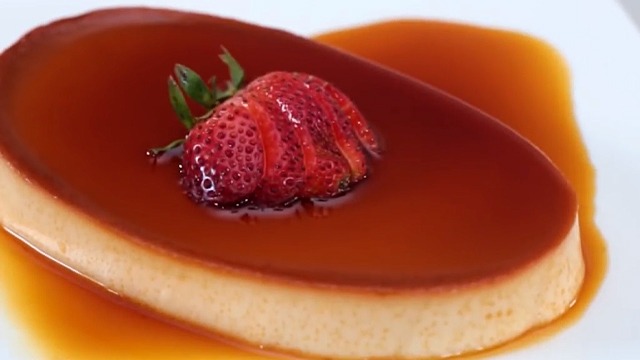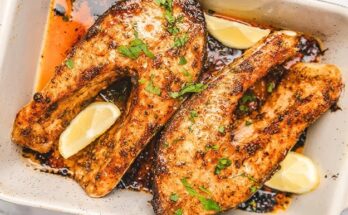Leche Flan Recipe: Leche Flan is more than just a dessert—it’s a piece of Filipino culture, a symbol of sweet celebrations, and a staple in nearly every family gathering. If you’ve ever attended a fiesta, birthday, or holiday event in the Philippines, chances are you’ve encountered this creamy, caramel-topped delight sitting proudly on the dessert table.
But what exactly is leche flan? At its core, leche flan is the Filipino version of crème caramel or caramel custard. It’s made from a rich blend of egg yolks, condensed milk, and evaporated milk, steamed or baked until set, and crowned with a golden syrup of caramelized sugar. The end result? A smooth, melt-in-your-mouth dessert that delivers a perfect balance of sweetness and richness.
Leche flan isn’t just a recipe—it’s a tradition. Passed down through generations, each family may add their own twist, but the heart of the dessert remains the same. Whether you’re trying it for the first time or looking to perfect your own version, this step-by-step guide will help you master the ultimate leche flan recipe.
Ingredients You’ll Need
Before diving into the steps, let’s talk ingredients. The beauty of leche flan lies in its simplicity. You don’t need a pantry full of exotic items to create this luscious treat—just a few key ingredients, most of which you probably already have at home.
Basic Ingredients List:
- 10 egg yolks – For that rich, velvety texture. (Use fresh eggs for best results.)
- 1 can (14 oz) sweetened condensed milk – Adds sweetness and body.
- 1 can (12 oz) evaporated milk – Balances the sweetness and gives the custard its creamy consistency.
- 1 cup granulated sugar – For the caramel topping.
- 1 tsp vanilla extract – To enhance the flavor.
Optional Additions for Flavor:
- Lemon or calamansi zest – Adds a citrusy brightness.
- Coconut milk – For a tropical twist.
- Cream cheese – For a creamier, cheesecake-like version.
These basic ingredients are flexible. Some people like to add a little salt to balance out the sweetness, while others experiment with pandan extract or even coffee for a modern spin.
The bottom line? Start with the classic, master it, then let your creativity take over.
Tools and Equipment Required
Making leche flan doesn’t require fancy equipment, but having the right tools can make the process smoother and the results more consistent. If you’re serious about getting that glossy top and velvety finish, here’s what you’ll need.
Essential Kitchen Tools:
- Llanera (traditional aluminum mold) – Shallow, oval-shaped pans are ideal, but ramekins or any heatproof mold work too.
- Steamer or oven with a water bath setup – For gentle cooking that prevents curdling.
- Mixing bowl – To combine your custard ingredients.
- Whisk or fork – For gentle mixing. Avoid beating to minimize bubbles.
- Strainer or sieve – Ensures a smooth custard texture.
- Cooking pot or saucepan – For melting sugar into caramel.
Alternatives You Can Use:
- No llanera? Use small cake pans or even muffin tins.
- No steamer? Use a large pot with a trivet and lid or bake using a bain-marie (water bath).
- No strainer? Use cheesecloth or a fine mesh sieve for the same result.
The idea is to keep things as bubble-free and even as possible, so don’t skip out on tools that help you achieve that smooth finish.
Step-by-Step Guide to Making Leche Flan
Alright, now comes the exciting part—bringing everything together. Follow these steps closely and you’ll end up with a leche flan that’s not only picture-perfect but also incredibly delicious.
Step 1 – Preparing the Caramel
Start by caramelizing the sugar. Place 1 cup of granulated sugar in your llanera or directly in a saucepan over medium heat. Stir gently and constantly until the sugar melts and turns a deep amber color. Be careful—it can go from golden to burnt in seconds.
Once the sugar is fully melted and golden, immediately pour or tilt the caramel to evenly coat the bottom of your mold. Let it cool and harden. This will become that signature golden topping when you invert the flan.
Step 2 – Mixing the Flan Mixture
In a large bowl, gently whisk together the 10 egg yolks, condensed milk, evaporated milk, and vanilla extract. The key word here is gently—you want to combine everything without incorporating air. Bubbles lead to holes in your flan, and no one wants that.
Strain the mixture through a fine sieve or cheesecloth at least twice to catch any egg bits and reduce bubbles. This ensures your flan will be silky smooth.
Step 3 – Straining and Pouring into the Mold
After you’ve strained the flan mixture, the next step is to pour it carefully into your caramel-lined mold or llanera. Pour slowly to avoid disturbing the caramel and introducing bubbles into the mixture.
If you notice any bubbles on top, you can gently pop them with a spoon or skim them off. Some even run a torch or lighter briefly across the surface to break up the bubbles (just be cautious). Once the mixture is in, lightly tap the mold on the counter to release any trapped air pockets.
Cover the mold with foil. This prevents water droplets from the steaming or baking process from falling onto the custard and ruining that smooth top.
Step 4 – Steaming or Baking the Flan
You’ve got two solid methods here: steaming or baking in a water bath (bain-marie). Both deliver silky, evenly cooked flan, so choose what works best for you.
Steaming Method:
- Set up your steamer over medium heat.
- Place the covered flan mold inside, making sure it’s stable.
- Steam for about 30 to 40 minutes, depending on the size of your mold.
- Check doneness by inserting a toothpick into the center—it should come out mostly clean.
Baking Method:
- Preheat your oven to 350°F (175°C).
- Place the mold in a larger baking dish.
- Pour hot water into the outer dish until it reaches halfway up the sides of the flan mold.
- Bake for about 45 minutes to an hour.
- Again, test for doneness with a toothpick.
Pro tip: Whether you’re baking or steaming, avoid opening the lid or oven door too often. Sudden temperature changes can cause the flan to crack or cook unevenly.
Step 5 – Cooling and Unmolding the Flan
Patience, my friend. Once your flan is done, resist the urge to unmold it right away. Let it cool completely at room temperature. Then refrigerate it for at least 4 hours—overnight is even better.
Once it’s well-chilled and firm, run a thin knife around the edges of the mold to loosen it. Place a serving plate over the top of the mold, then invert quickly and confidently. Tap the top if needed and gently lift the mold.
Voila! That golden caramel sauce will cascade down over the creamy flan, making it look as good as it tastes.
Tips for a Smooth, Creamy Flan
Making leche flan might seem straightforward, but achieving that perfect, ultra-smooth texture takes a little finesse. Let’s go through some practical tips to help you nail it every single time.
1. Use Only the Yolks (or Mostly Yolks)
Egg whites can make your flan rubbery. Stick with egg yolks if you want it rich and velvety. Some recipes call for a whole egg or two, but the majority should be yolks.
2. Don’t Beat the Eggs Too Hard
Whisk gently. You’re not trying to make scrambled eggs. The goal is to mix the ingredients just enough to combine them without incorporating too much air.
3. Always Strain the Mixture
Twice, if possible. This is non-negotiable for that ultra-smooth finish. It gets rid of any stubborn egg bits and air bubbles that could ruin the texture.
4. Steam Gently or Bake Evenly
Whether you’re steaming or baking, the heat should be gentle. Too high and you’ll curdle the custard. If steaming, keep the heat medium-low. If baking, a consistent 350°F with a proper water bath does the trick.
5. Chill Before Serving
Leche flan is best enjoyed cold. Chilling not only improves the texture but also deepens the flavor as the custard and caramel meld together.
6. Don’t Overcook
Overcooked flan turns rubbery and gets holes. Start checking for doneness at the minimum cook time and adjust from there.
These small details may seem nitpicky, but trust me—they make all the difference between an okay flan and one that’ll have your guests asking for seconds.
Serving Suggestions
Leche flan is already a star on its own, but the way you serve it can elevate the entire dessert experience. Presentation matters, especially when you want to impress guests or make your family feel special. Let’s talk about how to make your leche flan shine even brighter.
1. Serve It Cold for Maximum Flavor
Leche flan is best enjoyed straight from the fridge. The chilled custard feels luxurious on the tongue, and the caramel sauce becomes more viscous and flavorful as it melds with the custard. A few hours in the refrigerator allows the flavors to fully develop and settle, giving you a more harmonious taste.
2. Top It Creatively
Sure, leche flan is delicious on its own, but there’s nothing wrong with giving it a little flair:
- Fresh fruits like mango slices, strawberries, or blueberries offer a refreshing contrast.
- Grated coconut or latik (toasted coconut curds) adds a traditional twist and texture.
- Mint leaves can make it look more elegant.
- A sprinkle of sea salt on the caramel top can intensify the sweetness and bring in a gourmet touch.
3. Pair It With Other Desserts
Leche flan is incredibly versatile and pairs well with other Filipino favorites. Try serving it alongside:
- Halo-halo, where a slice of leche flan is the crowning glory.
- Ube halaya, to create a sweet, colorful duo of creamy textures.
- Rice cakes (kakanin) like bibingka or puto for a satisfying contrast in flavor and texture.
4. Serve in Individual Portions
If you’re hosting a party, making leche flan in ramekins or muffin tins is a great way to give everyone their own personal serving. It looks chic, and there’s no messy slicing involved.
However you decide to serve it, the goal is to highlight the smooth, luscious texture and rich caramel flavor that makes leche flan a beloved classic.
How to Store Leche Flan Properly
You’ve made a batch (or maybe two), and now you’ve got leftovers. Don’t worry—leche flan stores beautifully if done right. But there are some do’s and don’ts to follow to keep that perfect texture and flavor intact.
1. Use an Airtight Container
Transfer your cooled leche flan into an airtight container. If it’s in a llanera or a dish with a tight-fitting lid, that’s ideal. This helps prevent the flan from absorbing odors from the fridge, especially from pungent foods like garlic or fish.
2. Refrigeration is Key
Leche flan must be stored in the refrigerator. It should be consumed within 5 to 7 days for the best flavor and quality. Always store it chilled and avoid leaving it at room temperature for extended periods, especially in warm climates.
3. Can You Freeze It?
Technically, yes—you can freeze leche flan. But we don’t recommend it. Freezing changes the texture, making it grainy or watery upon thawing. If you absolutely must freeze it:
- Wrap the flan well with cling film and foil.
- Store it flat in the freezer for up to one month.
- Thaw in the fridge overnight, never at room temperature.
Still, it’s best to make and enjoy leche flan fresh or within a few days of preparation.
4. Reheating? Not Necessary
Leche flan is a cold dessert. Do not reheat it—it’s not meant to be warm. Just slice it straight from the fridge, pour a little extra caramel on top if needed, and enjoy.
By storing leche flan properly, you ensure every bite remains as delicious as the first.
Variations of Leche Flan
Once you’ve mastered the classic leche flan, it’s time to get adventurous. The beauty of this dessert is that it acts as a blank canvas for flavor experimentation. Whether you’re in the mood for something fruity, nutty, or even boozy, there’s a flan variation out there for you.
1. Ube Leche Flan
A trendy twist on the original, this variation combines the richness of leche flan with the vibrant purple color and earthy taste of ube (purple yam). You can either mix ube halaya into the custard or create a two-layer dessert with ube at the bottom and leche flan on top.
2. Coffee Leche Flan
Perfect for coffee lovers, adding espresso or strong brewed coffee to the custard mix creates a mocha-like dessert. The bitterness of the coffee cuts through the sweetness and adds a depth of flavor.
3. Cream Cheese Flan
Add softened cream cheese into the custard blend for a thicker, cheesecake-like texture. This version is incredibly rich and perfect for those who like dense, creamy desserts.
4. Coconut Milk Leche Flan
Swap out some or all of the evaporated milk for coconut milk to give the flan a tropical flair. It adds a subtle nutty taste and goes great with toppings like toasted coconut or caramelized bananas.
5. Alcohol-Infused Flan
For an adult-only version, you can spike your flan with a tablespoon of rum, Kahlua, or even Baileys Irish Cream. It adds complexity and makes it suitable for a more gourmet-style dessert.
Whether you’re sticking to the classic or experimenting with flavors, leche flan always finds a way to impress.
FAQs about Leche Flan Recipe
1. What is Leche Flan made of?
Leche Flan is a rich and creamy dessert made with just a few simple ingredients: egg yolks, sweetened condensed milk, evaporated milk, sugar (for the caramel), and a dash of vanilla extract.
2. Can I use whole eggs instead of just yolks?
Technically, yes—but you’ll end up with a firmer, less silky texture. Yolks alone give that signature custard-like creaminess everyone loves.
3. Do I need a llanera to make Leche Flan?
Nope! While the traditional llanera (oval tin mold) gives it that classic look, you can use ramekins, cake pans, or even muffin tins. Just make sure they’re heat-safe.
4. Why is my flan bubbly or full of holes?
That’s usually from overbeating or baking at too high a temperature. Steam it gently and avoid whipping air into the mixture for that smooth, velvety finish.
5. Can I bake Leche Flan instead of steaming?
Absolutely. Use a water bath (bain-marie) in the oven to mimic the gentle steam effect. It’s slower but equally effective.
6. How long does Leche Flan last in the fridge?
It keeps well for up to 4–5 days when stored in an airtight container. The flavor actually gets better the next day!
7. Can I freeze Leche Flan?
Technically yes, but it’s not ideal. Freezing changes the texture and can make it watery when thawed. Fresh is best.
8. Is Leche Flan the same as Crème Caramel?
They’re close cousins. Leche Flan is richer and denser due to more egg yolks and sweetened condensed milk. Crème Caramel is typically lighter and made with cream or milk and whole eggs.
9. What’s the best milk to use?
A combo of evaporated milk and sweetened condensed milk is traditional and creates the richest taste. Some modern twists use coconut milk for a dairy-free version.
10. How do I know when it’s done?
The flan should jiggle slightly in the center like Jell-O when tapped. Stick a toothpick in—it should come out clean or with just a hint of custard.
Conclusion
What makes leche flan so special is its simplicity. With just a few ingredients—eggs, milk, sugar—you can create a luxurious dessert that feels like a treat from a fancy patisserie. It’s rich, silky, and sweet with just the right hint of bitterness from the caramel. Whether you’re making it for a fiesta, a family get-together, or simply to satisfy your sweet tooth, leche flan is always a good idea.
The best part? You can easily tweak it to fit your taste. Want it richer? Add more yolks. Want to try a twist? Go for ube or coconut milk. Want to impress guests? Serve it in individual molds with a fruit garnish. It’s that versatile.
Now that you’ve got the ultimate step-by-step guide, there’s no reason not to try making it yourself. Trust me—once you do, you’ll never look at store-bought flan the same way again.



